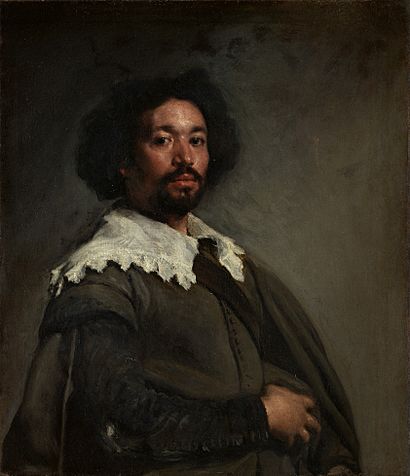Portrait of Juan de Pareja facts for kids
Quick facts for kids Portrait of Juan de Pareja |
|
|---|---|
 |
|
| Artist | Diego Velázquez |
| Year | c. 1650 |
| Medium | Oil on canvas |
| Dimensions | 81.3 cm × 69.9 cm (32.0 in × 27.5 in) |
| Location | Metropolitan Museum of Art, New York City |
The Portrait of Juan de Pareja is a famous painting by the Spanish artist Diego Velázquez. It shows Juan de Pareja, who was an artist himself and worked for Velázquez when the painting was made. Velázquez painted this portrait in Rome, Italy, around 1650.
This painting is special because it's the earliest known portrait of a Spanish man of African descent. It was also the first painting ever to sell for more than £1,000,000! When the Metropolitan Museum of Art bought it in 1970, they called it one of their most important new artworks. You can see the painting today at the Metropolitan Museum of Art in New York City.
Contents
The Story Behind the Painting
In 1649, Philip IV of Spain sent Diego Velázquez to Rome. Velázquez was the king's court painter, and his job was to buy art for the royal palace in Madrid. Juan de Pareja traveled with Velázquez. Juan helped Velázquez in his art studio.
While in Rome, Velázquez painted this portrait of Juan de Pareja. The painting was shown to the public at the Pantheon on March 19, 1650. Other artists loved it! One writer, Antonio Palomino, said that other paintings in the show were just "art," but Velázquez's portrait of Juan de Pareja was "truth."
Velázquez painted Juan de Pareja to practice for another very important portrait. He was preparing to paint Pope Innocent X. The Pope had a reddish face and would wear bright pink and red robes. Painting him would be a challenge! Velázquez needed to work quickly and capture the Pope's true personality.
The Portrait of Juan de Pareja helped Velázquez get ready for this difficult task. He used a limited number of colors. But he used loose, quick brushstrokes. This made the painting feel very alive and real.
Juan de Pareja (who lived from about 1610 to 1670) later became a well-known artist himself. Velázquez gave Juan his freedom in 1654.
Where the Painting Has Been
We don't know much about who owned the painting between 1650 and the late 1700s. It wasn't recorded in Spain. The first time we hear about its owner is in 1765. A writer named Francisco Preciado said the painting belonged to Cardinal Troiano Acquaviva d'Aragona in Rome.
Later, the painting was part of a collection in Naples. Then, Sir William Hamilton, the British Ambassador to Naples, owned it. He listed it as "a portrait of a Moresco slave by Velazquez" in his home. When he left Naples, he sent the painting to London for safety. It traveled on a ship led by Lord Nelson.
Sir William Hamilton had money problems. So, the portrait was sold at an auction in London in 1801. The auction catalog called it "Portrait of a Moorish Slave, that was in his service, and became a great Painter." It sold for a small amount and then disappeared again.
The painting later appeared in the collection of Jacob Pleydell-Bouverie, 2nd Earl of Radnor at Longford Castle in England. It stayed with the Radnor family for over 150 years. In 1970, it was sold again at Christie's in London. It set a new record, selling for £2,310,000! This was the first time a painting sold for over £1,000,000 at an auction.
Alec Wildenstein, an art dealer, bought the painting for the Metropolitan Museum of Art. The Museum officially got the painting in 1971. It is still considered one of the most important artworks the Museum has ever bought.
There is also a very good copy of the painting at the Hispanic Society of America in New York. Some people think Juan de Pareja himself painted this copy.
How the Painting Inspired Others
Velázquez's portrait has inspired many other artists and writers:
- The 1965 novel I, Juan de Pareja by Elizabeth Borton de Treviño was inspired by the painting. This book won the Newbery Medal in 1966, a top award for children's literature.
- The surrealist painter Salvador Dalí created his own version in 1960. It's called Portrait of Juan de Pareja, the Assistant to Velázquez.
- French-Senegalese artist Iba N'Diaye also reinterpreted the portrait in his 1985–86 painting Juan de Pareja agresse par les chiens (Juan de Pareja menaced by dogs).
- The 2012 play Disgraced by Ayad Akhtar features a painting inspired by the Portrait of Juan de Pareja.
See also
 In Spanish: Retrato de Juan de Pareja para niños
In Spanish: Retrato de Juan de Pareja para niños
- List of works by Diego Velázquez

